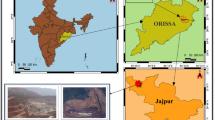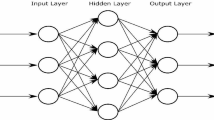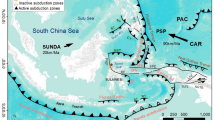Abstract
Ground motion prediction equations (GMPEs) are open challenge problems that have been developed since 1964. Parametric and nonparametric methods predict ground motion characteristics such as peak ground acceleration (PGA), velocity, displacements, and spectral accelerations. In the present study, the grey wolf optimization (GWO) algorithm was used to obtain a new and developed GMPE for predicting PGA. Data from recorded earthquakes from all over the world were collected, and after filtering of Mw and distance parameters, close to 2000 data were used for modelling. Three parameters of Mw (4–7.9), epicentral distance (0.25–115 km) and geological conditions (soft soil, stiff soil, rock) were used as input parameters for estimating PGA. Many previous studies classified geological conditions based on shear wave velocity at the top 30 m (Vs30), without taking into account the effect of Vs30 at each group. In this study, the effects of Vs30 were considered separately for each geological group too. Results showed that PGA decreased by increasing Vs30 and moving from soft soil toward rock. Finally, the relationship was compared with the other two relations suggested for the local region and global earthquakes, and despite the simplicity of the suggested relation gained by the GWO method, it estimated PGA in terms of accuracy to a good and acceptable level.








Similar content being viewed by others
Data Availability
The data underlying this article are collected and processed by the Pacific Earthquake Engineering Research (PEER) center and are available online at http://peer.berkeley.edu/ngawest2/databases/.
References
Abrahamson NA, Silva WJ (2008) Summary of the Abrahamson & Silva NGA ground-motion relations. Earthq Spectra 24:67–97. https://doi.org/10.1193/1.2924360
Abrahamson NA, Silva WJ, Kamai R (2014) Summary of the ASK14 ground motion relation for active crustal regions. Earthq Spectra 30(3):1025–1055. https://doi.org/10.1193/070913EQS198M
Ahmad I, El Naggar MH, Khan AN (2008) Neural net- work based attenuation of strong motion peaks in Europe. J Earthq Eng 12(5):663–680
Aki K (1957) Space and time spectra of stationary stochastic waves, with special reference to microtremors. Bulletin of the Earthquake Research Institute. Univer Tokyo 35:415–457
Alavi AH, Gandomi AH (2011) Prediction of principal ground-motion parameters using a hybrid method coupling artificial neural networks and simulated annealing. Comput Struct 89(23):2176–2194
Ambraseys N, Douglas J (2000) Reappraisal of the effect of vertical ground motions on response. ESEE Report 00–4. Department of Civil and Environmental Engineering, Imperial College, London. http://www.esee.cv.ic.ac.uk/reports.htm
Ambraseys NN, Douglas J, Sarma SK, Smit PM (2005a) Equations for the estimation of strong ground motions from shallow crustal earthquakes using data from Europe and the Middle East: horizontal peak ground acceleration and spectral acceleration. Bull Earthq Eng 3:1–53. https://doi.org/10.1007/s10518-005-0183-0
Ambraseys NN, Douglas J, Sarma SK, Smit PM (2005b) Equations for the estimation of strong ground motions from Shallow crustal earthquakes using data from Europe and the middle east: vertical peak ground acceleration and spectral acceleration. Bull Earthq Eng 3:55–73. https://doi.org/10.1007/s10518-005-0186-x
Ambraseys NN, Simpson KA (1996) Prediction of vertical response spectra in Europe. Earthq Eng Struct Dynam 25(4):401–412. https://doi.org/10.1002/(SICI)1096-9845(199604)25:4%3c401::AID-EQE551%3e3.0.CO;2-B
Ambraseys NN, Simpson KA, Bommer JJ (1996) Prediction of horizontal response spectra in Europe. Earthq Eng Struct Dynam 25(4):371–400. https://doi.org/10.1002/(SICI)1096-9845(199604)25:4%3c371::AID-EQE550%3e3.0.CO;2-A
Amiri GG, Mahdavian A, Manouchehri-Dana F (2007) Attenuation relationships for Iran. J Earthq Eng 11(4):469–492. https://doi.org/10.1080/13632460601034049
Ancheta TD, Darragh RB, Stewart JP, Seyhan E, Silva WJ, Chiou BSJ, Wooddell KE, Graves RW, Kottke AR, Boore DM, Kishida T, Donahue JL (2014) NGA-West2 database. Earthq Spectra 30(3):989–1005. https://doi.org/10.1193/070913EQS197M
Anderson JG (1991) Strong motion seismology. Rev Geophys 29:700–720
Atkinson G (1997) Empirical ground motion relations for earthquakes in the Cascadia region. Can J Civ Eng 24:64–77
Atkinson G, Boore M (2003a) Empirical ground-motion relations for subduction-zone earthquakes and their application to cascadia and other regions. Bull Seismol Soc Am 93(4):1703–1729. https://doi.org/10.1785/0120020156
Atkinson GM (2001) An alternative to stochastic ground-motion relations for use in seismic hazard analysis in eastern North America. Seismol Res Lett 72:299–306. https://doi.org/10.1785/gssrl.72.2.299
Atkinson GM, Boore DM (2003b) Empirical ground-motion relations for subduction zone earthquakes and their application to Cascadia and other regions. Bull Seismol Soc Am 93(4):1703–1729. https://doi.org/10.1785/0120080108
Bindi D, Massa M, Luzi L (2014) Erratum to: Pan-European ground-motion prediction equations for the average horizontal component of PGA, PGV, and 5 %-damped PSA at spectral periods up to 3.0 s using the RESORCE dataset. Bull Earthq Eng 12:431–448. https://doi.org/10.1007/s10518-014-9589-x
Bommer JJ, Elnashai AS, Chlimintzas GO, Lee D (1998) Review and development of response spectra for displacement based seismic design. ESEE Report 98-3, Department of Civil Engineering, Imperial College, London
Boore DM (1983) Strong-motion seismology. Rev Geophys Space Phys 21(6):1308–1318
Boore DM, Atkinson GM (2008) Ground-motion prediction equations for the average horizontal component of PGA, PGV, and 5%-damped PSA at spectral periods between 0.01 s and 10.0 s. Earthq Spectra 24:99–138. https://doi.org/10.1193/1.2830434
Boore DM, Joyner WB, Fumal TE (1993) Estimation of response spectra and peak accelerations from western North American earthquakes: an interim report. Open-File Report. US Geological Survey 93-509
Boore DM, Joyner WB, Fumal TE (1997) Equations for estimating horizontal response spectra and peak acceleration from western North American earthquakes: a summary of recent work. Seism Res Lett 68:128–153
Boore DM, Stewart JP, Seyhan E, Atkinson GM (2014) NGA-West2 equations for predicting PGA, PGV, and 5% damped PSA for shallow crustal earthquakes. Earthq Spectra 30:1057–1085. https://doi.org/10.1193/070113EQS184M
Bozorgnia Y, Campbell KW (2004) The vertical-to-horizontal response spectral ratio and tentative procedures for developing simplified V/H and the vertical design spectra. J Earthq Eng 8(2):175–207. https://doi.org/10.1080/13632460409350486
Bozorgnia Y, Campbell KW, Niazi M (2000) Observed spectral characteristics of vertical ground motion recorded during worldwide earthquakes from 1957 to 1995. In: Proceedings of 12th world conference on earthquake engineering. Paper no. 2671
Campbell KW, Bozorgnia Y (2000) New empirical models for predicting near-source horizontal, vertical, and V/H response spectra: implications for design. In: Proceedings of the 6th international conference on seismic zonation
Campbell KW, Bozorgnia Y (2003) Updated near-source ground- motion (attenuation) relations for the horizontal and vertical components of peak ground acceleration and acceleration response spectra. Bull Seismol Soc Am 93(1):314–331. https://doi.org/10.1785/0120020029
Campbell KW, Bozorgnia Y (2008) NGA ground motion model for the geometric mean horizontal component of PGA, PGV, PGD and 5% damped linear elastic response spectra for periods ranging from 0.01 to 10 s. Earthq Spectra 24:139–171. https://doi.org/10.1193/1.2857546
Campbell KW, Bozorgnia Y (2014) NGA-West2 ground motion model for the average horizontal components of PGA, PGV, and 5% damped linear acceleration response spectra. Earthq Spectra 30:1087–1115. https://doi.org/10.1193/062913EQS175M
Chiou BSJ, Youngs RR (2008) An NGA model for the average horizontal component of peak ground motion and response spectra. Earthq Spectra 24:173–215. https://doi.org/10.1193/1.2894832
Chiou BSJ, Youngs RR (2014) Update of the Chiou and Youngs NGA model for the average horizontal component of peak ground motion and response spectra. Earthq Spectra 30:1117–1153. https://doi.org/10.1193/072813EQS219M
Crouse C, Vyas Y, Schell B (1998) Ground motions from subduction zone earthquakes. Bull Seism Soc Am 78:1–25
De Natale G, Faccioli E, Zollo A (1988) Scaling of peak ground motions from digital recordings of small earthquakes at Campi Flegrei, southern Italy. Pure Appl Geophys 126(1):37–53
Dhanya J, Raghukanth STG (2018) Ground motion prediction model using artificial neural network. Pure Appl Geophys 175:1035–1064. https://doi.org/10.1007/s00024-017-1751-3
Dorigo M, Birattari M, Stutzle T (2006) Ant colony optimization. Comput Intell Mag, IEEE 1:28–39
Douglas J (2002) Earthquake ground motion estimation using strong-motion records: a review of equation for the estimation of peak ground acceleration and response spectral ordinate. Earth Sci Rev 61:43–104. https://doi.org/10.1016/S0012-8252(02)00112-5
Douglas J (2004) Ground motion estimation equations 1964–2003: reissue of ESEE Report 01-1: ‘a comprehensive worldwide summary of strong-motion attenuation relationships for peak ground acceleration and spectral ordinates (1969 to 2000)’ with corrections and additions, Tech. rept. 04-001-SM. Department of Civil and Environmental Engineering; Imperial College of Science. Technology, and Medicine; London
Douglas J (2010) Consistency of ground-motion predictions from the past four decades. Bull Earthq Eng 8:1515–1526. https://doi.org/10.1007/s10518-010-9195-5
Douglas J (2016) Ground motion prediction equations 1964–2016. http://www.gmpe.org.uk. Accessed 20 Dec 2017
Douglas J (2021) Ground Motion Prediction Equations 1964–2020. Department of Civil End Environmental Engineering, University of Strathclyde, Glasgow
Douglas JA (2001) critical reappraisal of some problems in engineering seismology. PhD thesis. University of London
Draper NR, Smith H (1981) Applied regression analysis, 2nd edn. Wiley
Esteva L, Rosenblueth E (1964) Espectros de temblores a distancias moderadas y grandes. Bol Soc Mex Ing Sesm 2:1–18
Faris H, Aljarah I, Al-Betar MA, Mirjalili S (2018) Grey wolf optimizer: a review of recent variants and applications. Neural Comput Appl 30(2):413–435. https://doi.org/10.1007/s00521-017-3272-5
Ghalehjough BK, Mahinroosta R (2020) Peak ground acceleration prediction by fuzzy logic modeling for Iranian plateau. Acta Geophys 68:75–89. https://doi.org/10.1007/s11600-019-00394-z
Gholizadeh S (2015) Optimal design of double layer grids considering nonlinear behaviour by sequential grey wolf algorithm. Iran Univer Sci Technol 5(4):511–523. http://ijoce.iust.ac.ir/article-1-231-en.html
Gupta p, Kumar V, Rana KPS, Mishra P (2015) Comparative study of some optimization techniques applied to Jacketed CSTR control. In: 4th international conference on reliability, infocom technologies and optimization (ICRITO) (trends and future directions), pp 1–6. https://doi.org/10.1109/ICRITO.2015.7359368
Hameed IA, Bye RT Osen OL (2016) Grey wolf optimizer (GWO) for automated offshore crane design. IEEE Symp Ser Comput Intell (SSCI). https://doi.org/10.1109/SSCI.2016.7849998
Herrmann RB, Goertz MJ (1981) A numerical study of peak ground motion scaling. Bull Seismol Soc Am 71(6):1963–1979
Idriss IM (1990) Response of soft soil sites during earthquakes. In: Duncan JM (ed) Proceedings. H. Bolton seed memorial symposium, vol 2. BiTech Published, Vancouver, pp 273–289
Idriss IM (2008) An NGA empirical model for estimating the horizontal spectral values generated by shallow crustal earthquakes. Earthq Spectra 24:217–242. https://doi.org/10.1193/1.2924362
Idriss IM (2014) An NGA-West2 empirical model for estimating the horizontal spectral values generated by shallow crustal earthquakes. Earthq Spectra 30:1155–1177. https://doi.org/10.1193/070613EQS195M
Joyner WB (1987) Strong-motion seismology. Rev Geophys 25(6):1149–1160. https://doi.org/10.1029/RG025i006p01149
Joyner WB, Boore DM (1981) Peak horizontal acceleration and velocity from strong-motion records including records from the 1979 Imperial Valley. California, earthquake. Bull Seismol Soc Am 71(6):2011–2038
Joyner WB, Boore DM (1988) Measurement, characterization, and prediction of strong ground motion. In: Proceedings of earthquake engineering and soil dynamics II, geotechnical division ASCE 43-102
Jozinović D, Lomax A, Štajduhar I, Michelini A (2020) Rapid prediction of earthquake ground shaking intensity using raw waveform data and a convolutional neural network. Geophys J Int. https://doi.org/10.1093/gji/ggaa233
Kadas K, Yakut A, Kazaz I (2011) Spectral ground motion intensity based on capacity and period elongation. J Struct Eng 137:401–409. https://doi.org/10.1061/(ASCE)ST.1943-541X.0000084
Karaboga D (2005) An idea based on honey bee swarm for numerical optimization. Technical Report-TR06, Erciyes University, Engineering Faculty, Computer Engineering Department, vol 200, pp 1–10. https://doi.org/10.4236/jss.2015.36009
Kennedy J, Eberhart R (1995) Particle swarm optimization, in Neural Networks, In: Proceedings, IEEE international conference 1942–1948. https://doi.org/10.1109/ICNN.1995.488968
Khademi MH (2002) Attenuation of peak and spectral accelerations in the Persian plateau. In: Proceedings of 12th European conference on earthquake engineering. Paper Reference 330
Kobayashi S, Takahashi T, Matsuzaki S, Mori M, Fukushima Y, Zhao JX, Somerville PG (2000) A spectral attenuation model for Japan using digital strong motion records of JMA87 type. In: Proceedings of 12th world conference on earthquake engineering, Paper No 2786
Kramer SL (1996) Geotechnical earthquake engineering. Prentice-Hall Inc, Upper Saddle River
Laurie G, Baise Eric M (2011) Thompson, incorporating site effects in ground motion prediction equations. Final Technical Report. USGS Award Number G11AP20033
Lawson RS, Krawinkler H (1994) Cumulative damage potential of seismic ground motion. Proc Tenth Eur Confer Earthq Eng 2:1079–1086
Louie JN (2001) Faster, better: shear-wave velocity to 100 meters depth from refraction microtremor arrays. Bull Seismol Soc Am 91:347–364
Maroufpoor S, Maroufpoor E, Bozorg-Haddad O, Shiri J, Yaseen ZM (2019) Soil moisture simulation using hybrid artificial intelligent model: hybridization of adaptive neuro fuzzy inference system with grey wolf optimizer algorithm. J Hydrol 575:544–556
McGuire RK (1974) Seismic structural response risk analysis, incorporating peak response regressions on earthquake magnitude and distance. Research Report R74-51, Massachusetts Institute of Technology. Department of Civil Engineering, Cambridge. USA
Mirjalili S, Mirjalili SM, Lewis A (2014) Grey wolf optimizer. Adv Eng Softw 69:46–61. https://doi.org/10.1016/j.advengsoft.2013.12.007
Nadimi-Shahraki MH, Taghian S, Mirjalili S (2021) An improved grey wolf optimizer for solving engineering problems. Expert Syst Appl 166:113917. https://doi.org/10.1016/j.eswa.2020.113917
Okada H (2003) The microtremor survey method. Geophysical monograph. Society of Exploration Geophysicists, vol 12
Ozmen B, Babsbug Erkan BB (2014) Probabilistic earthquake hazard assessment for Ankara and its environs. Turk J Earth Sci 23:462–474. https://doi.org/10.3906/yer-1302-6
Rucker ML (2003) Applying the refraction microtremor (ReMi) shear wave technique to geotechnical characterization. In: Proceedings of the 3rd ınternational conference on application of geophysical methodologies and NDT to transportation and ınfrastructure, Orlando, FL, pp 8–12
Sadigh K, Chang CY, Egan JA, Makdisi F, Youngs RR (1997) Attenuation relationships for shallow crustal earthquakes 102 J. Douglas, Earth-Science Reviews 61 (2003) 43–104 based on California strong motion data. Seismol Res Lett 68(1):180–189
Schnabel PB, Seed HB (1973) Accelerations in rock for earthquakes in the western United States. Bull Seismol Soc Am 63(2):501–516
Shiuly A, Roy N, Sahu RB (2020) Prediction of peak ground acceleration for Himalayan region using artificial neural network and genetic algorithm. Arab J Geosci 13:215. https://doi.org/10.1007/s12517-020-5211-5
Shoushtari AV, Adnan AB, Zare M (2016) On the selection of ground–motion attenuation relations for seismic hazard assessment of the Peninsular Malaysia region due to distant Sumatran subduction intraslab earthquakes. Soil Dyn Earthq Eng 82:123–137. https://doi.org/10.1016/j.soildyn.2015.11.012
Sun SS, Sung DC, Yong RK (2002) Empirical evaluation of a fuzzy logic-based software quality prediction model. http://dl.acm.org/citation.cfm?id=765833. Accessed 15 May 2016
Thomas S, Pillai GN, Pal K, Jagtap P (2016) Prediction of ground motion parameters using randomized ANFIS (RANFIS). Appl Soft Comput 40:624–634. https://doi.org/10.1016/j.asoc.2015.12.013
Usta YB, Sayıl N (2022) Estimation of site dynamic characteristics using ambient noise measurements in KTU campus, Trabzon, NE Turkey. Arab J Geosci 15:125. https://doi.org/10.1007/s12517-021-08887-2
Wadia-fascetti S, Gunes B (2000) Earthquake response spectra models incorporating fuzzy logic with statistics. Comput-Aided Civil Infrastruct Eng 15(2):134–146. https://doi.org/10.1111/0885-9507.00178
Youngs R, Day S, Stevens J (1998) Near field ground motions on rock for large subduction zone earthquakes. In: Earthquake engineering and soil dynamics II. American Society of Civil Engineers Geotech. Special Publication No 20, pp 445–462
Zare M, Sabzali S (2006) Spectral attenuation of strong motions in Iran. In: 3rd international symposium on the effects of surface geology on seismic motion grenoble, France
Funding
The authors did not receive support from any organization for the submitted work.
Author information
Authors and Affiliations
Corresponding author
Ethics declarations
Conflict of interest
The Authors have no competing interests to declare that are relevant to the content of this article.
Additional information
Edited by Dr. Aybige Akinci (ASSOCIATE EDITOR) / Prof. Ramón Zúñiga (CO-EDITOR-IN-CHIEF).
Rights and permissions
Springer Nature or its licensor (e.g. a society or other partner) holds exclusive rights to this article under a publishing agreement with the author(s) or other rightsholder(s); author self-archiving of the accepted manuscript version of this article is solely governed by the terms of such publishing agreement and applicable law.
About this article
Cite this article
Karimi Ghalehjough, B., Agahian, S. Application of grey wolf optimizer to develop new global GMPE for estimating peak ground acceleration. Acta Geophys. 71, 2149–2161 (2023). https://doi.org/10.1007/s11600-023-01028-1
Received:
Accepted:
Published:
Issue Date:
DOI: https://doi.org/10.1007/s11600-023-01028-1




